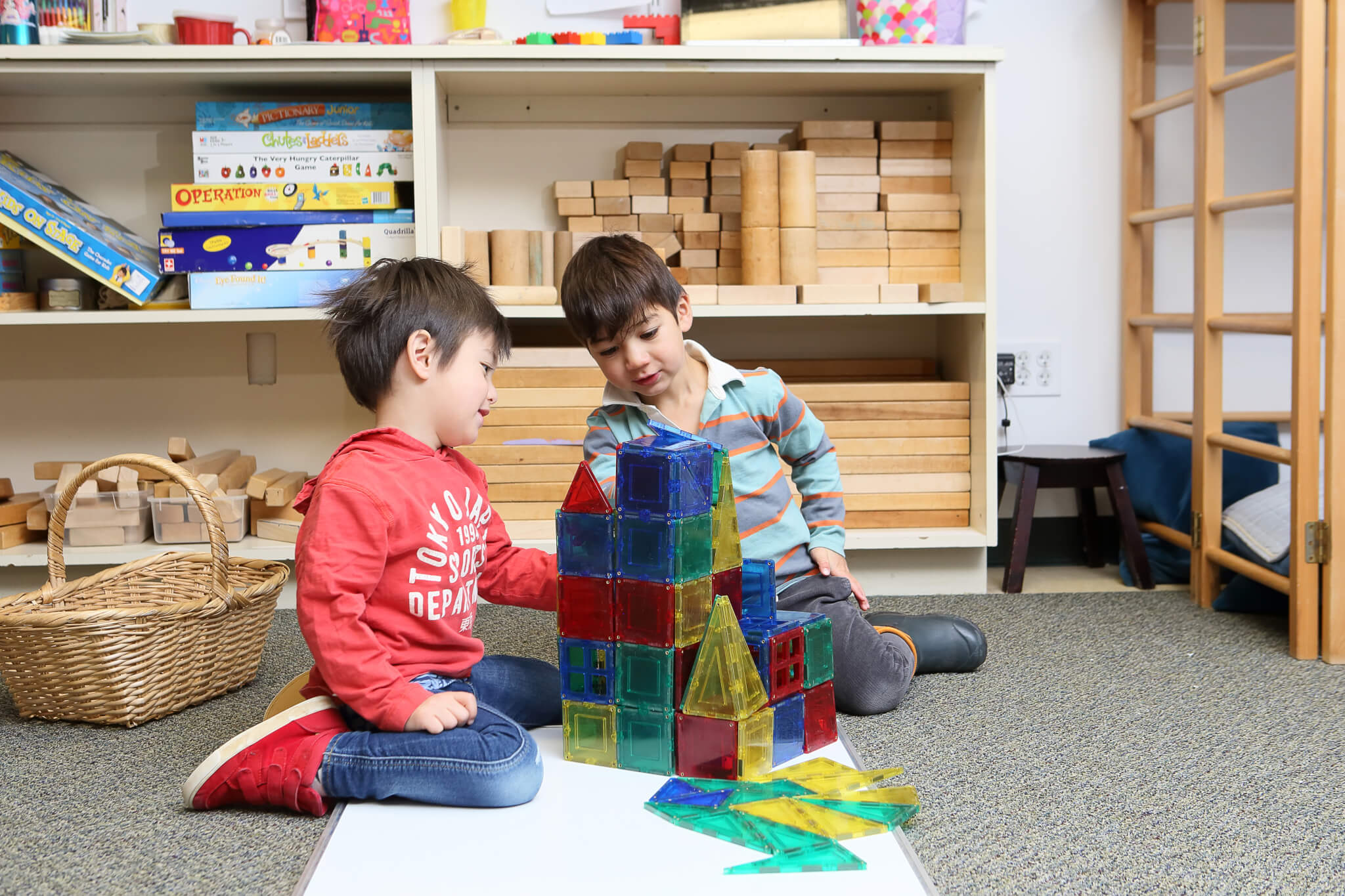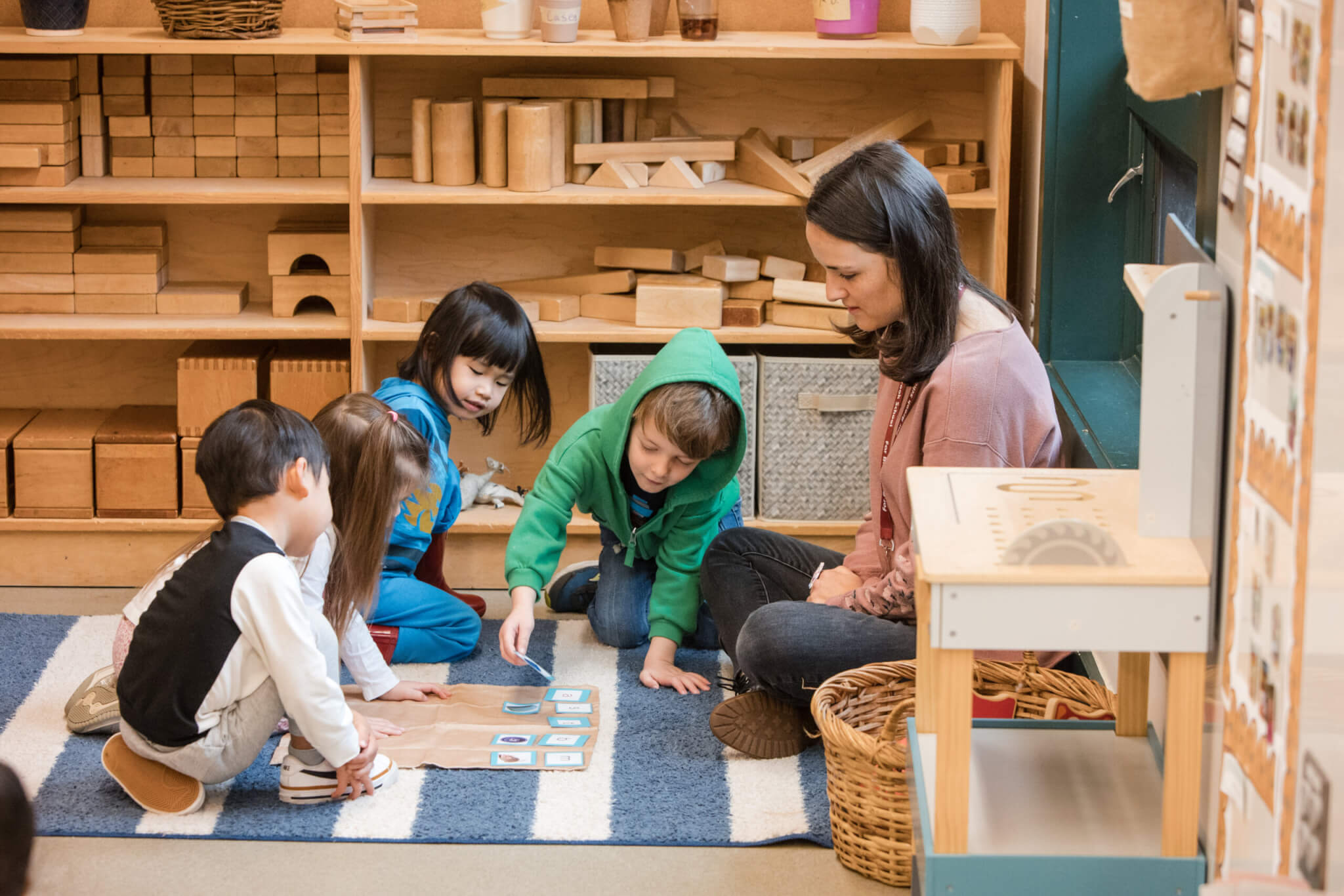Nursery 3s
The Seasons: How Do My Senses Help Me Experience The World?
Core Curriculum
The Nursery 3s program is the beginning of a child’s Far Brook experience. The curriculum is thoughtfully designed to bridge the child’s home life and school life. In a warm and unhurried environment, we take time and care to gradually transition and acclimate our students to the classroom and culture of the school. As time progresses, topics are presented that entice children to learn about themselves and the world around them. A yearlong theme about seasons, with a focus on weather, plants, animals and their behaviors, allows students to understand their role and value in the world in greater depth. Through experiential and hands-on learning, children approach and embrace each subject at their level of ability and interest. Students observe, investigate, analyze, and explore the world around them by broadening knowledge and strengthening skills. Our Nursery 3s program is an essential part of the Early Childhood program, in which students begin their journey as a lifelong learner.
Literacy
In the Nursery 3s class, students are immersed in a world with rich and sophisticated language – learning to build on their expressive and receptive language on a daily basis. Students engage in activities with visually attractive books, games, music, art, and play that cultivate a rich vocabulary and spoken language, which is the scaffolding for future literacy skills. Lifelong love of reading and storytelling is instilled through reading, retelling, and analyzing books, through dramatic play and art projects that allow for self-expression. We support language for communication through social interactions and play with peers, older students and teachers.
Math
The Nursery 3s explore numbers, shapes, and patterns, and develop math concepts in a variety of ways both inside the classroom and in the outdoor environment. We present books, games, songs, art and play activities that require students to count with one-to-one correspondence and understand quantities. We provide opportunities that encourage mathematical curiosity and allow students to see math as an exciting, natural, and essential part of their world.
Science
Nursery students explore the themes of colors in nature, seasonal change, animal families, and weather concepts such as ice, water, and wind, all using their five senses. The students explore through hands-on activities and time outdoors, making careful observations and sharing their thinking through drawing, making and finding creative ways to express their understanding of the world. Often a story (fiction and/or non-fiction) at the beginning of class gives us a jumpstart into connecting our observations and ideas to real life experiences. Students observe and care for classroom animals, gain experience with scientific tools like magnifying glasses, and experience connections with the core curriculum.
Library
In Nursery, students build up their pre-literacy skills in their weekly library class by using a book’s illustrations as clues to understand the meaning of a story. They practice “reading” and mimicking the non-verbal expressions and emotions of characters in books as a key stepping-stone in the development of empathy. They begin to explore the difference between fiction and non-fiction and to learn how the spine label on a library book can help them to determine whether a book is an expression of the author’s imagination or a source of factual information.
World Languages
French and Spanish classes are designed to follow as closely as possible the process by which children acquire their first language. The children are immersed in a language-rich environment made comprehensible through the use of body language, visual aids, and abundant repetition in a variety of contexts. The teacher uses mainly story-based activities to bring the language to life. Through careful scaffolding of new and recycled words, the children acquire a foundation of basic vocabulary, and simple useful phrases. A typical lesson will include some of the following: puppets, movement, imaginative play, games, music, and drawing. The focus is mainly on listening, and understanding what is said as the students acquire the language while participating in interactive age- appropriate activities.
Fine Arts
Art: In the Nursery program students are encouraged to enjoy the process of producing art. They develop confidence in the use of tools, techniques, and methods, while looking at masterworks of artists across many genres in art history. Hands-on experimentation with a variety of media, invites students to develop critical thinking and critical feeling skills through their own original masterworks. Students are encouraged to participate in direct observation as well as imaginative thinking while making art. Frequently, the core curriculum is referenced with a visual study of themselves, their family, and the world around them; focusing mostly on portraiture, colors, and patterns.
Design Thinking and Woodshop: In the Nursery woodshop classroom, the students are slowly and deliberately introduced to the woodshop tools. Each project teaches a new tool or skill to the students. Nursery students begin working with rasps and sandpaper, then hammers and nails, and eventually, light cutting with a coping saw.
Performing Arts
Music: Our goals in Nursery are to inspire appropriate and imaginative responses to music using the voice and the body, and to lay groundwork for music literacy through guided critical listening. The students sing and move by using folk songs, games, chants, finger plays, gross motor movement activities, and listening exercises. Materials include American folk songs and games, Far Brook songs, songs and games from around the world in their original language (such as Spanish, French, Japanese, Maori and Chinese), and formal repertoire of the classical canon, with a focus on Saint-Säens’ Carnival of the Animals. The overarching theme to our repertoire selection in Nursery is “Animals and Food!” Students learn to respond to music individually (hopping, skipping, finger plays), in groups (circles, partners), and with vocal sounds (animal sounds, head voice, and melodic singing). Specialized activities encourage students to listen critically (matching pitch, recognizing individual instruments, high sounds and low sounds, loud and soft). Participation in and observation of Far Brook traditions allow Nursery students to gain a sense of themselves as being a part of a larger community that values singing together. Students are encouraged to sing when participating in Morning Meeting.
Dance: Dance for Nursery students is an introduction to movement and creativity, with an emphasis on game-playing and active learning with our bodies. Students learn the importance of listening to others, both verbally and visually, and assuming the roles of both leader and follower in weekly dance activities. Creative dances are made with direction from the dance teaching artists and incorporating movement invention from the students, building towards the performance of dance work the following years in Kindergarten and beyond.
Sports
The Sports program is designed to develop Nursery 3s students’ locomotor, visual motor skills and their spatial awareness as they move about in the gym and on the field. They explore different equipment and manipulatives. Students engage in activities that enhance their social as well as physical well-being. They are encouraged to participate, explore, and have fun in a safe environment.
Social and Emotional
The social and emotional development of our students is an essential, yearlong focus in the Nursery 3s class. A primary goal for the year is to provide support to students and families to foster a smooth separation from home to school. Far Brook provides a caring and nurturing environment for our students to help build strong and trusting relationships with teachers. Providing opportunities for individualized, exciting hands-on activities encourages our students’ independence. Play in small and large group settings encourages opportunities to develop friendships. Modeling language for communication and guiding students through social negotiations and conflict resolutions is an important part of each Nursery 3s day and a building block to future social emotional success.



View Curriculum Guide in ISSUU
